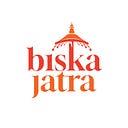Bode Biska Jatra
An Annual Parade of Faith and Tradition
On the day before the Nepali New Year, the Mahalaxmi temple becomes the centre of the Yonshi Thanegu (य:सिं थनेगु) program. People gather around as a long wooden pole, called Yonshi (य:सिं), is erected in front of the temple. It is believed that whoever participates in carrying it brings goodness to their life. It’s a sight that fills with awe and wonder. In the evening, the guńshi choyekegu (गुंसिछवयकेगु- carrying out a bonfire) takes place in front of the piercer’s house. This marks the beginning of the Mepwakhanegu jatra(म्येप्वा: खनेगु जात्रा Tongue Piercing Festival). Read more about it here.
On Baishakh 1, the festivities get more vibrant. On this day, it is customary to hold the pasta thayegu (apology worship) at Mahalaxmi Temple. Early in the morning, people participate in Dyo Mhulau (द्य: म्हुलेगु) at Mahalaxmi Temple. People join this circumambulation, where they circumambulate the temple throughout the day, showing respect and faith in the deity and welcoming the new year differently.
In the mid-day, Rathpuja gets started. It is a public procession involving participants adorned in traditional attire and ornaments, offering offers to the 32 palanquin deities scattered across Madhyapur.
At midnight, around 11 PM, Chanhesiya Jatra (चान्हेसिया जात्रा) takes place in Bode. People from every home participate with Chilakh (चिलाख— a firelight), and the khat (palanquin) of Kumari is upheld and paraded. The Kumari deity resides in Lachhi tole, and the khat is drawn down to the Kalika Mai temple, where it is paraded three times and rested there. Then the Dhimay baja (धिमे बाजा) and people carrying chilakh take part in holding other deities like Pancho Ganesh (पाचो गणेद्य:), Hasimala Ganesh (हासिमला गणेद्य:), Bhorikha Ganesh (भोरिखा गणेद्य:), Dhon: Barahi (धों बाराही), Ga:shi Barahi (ग:सिं बाराही), Mahalaxmi (महालक्ष्मी), and Bhairav (भैल द्य:) from their respective shrines and make them rest across the Pancho Ganesh premises. Until early morning, people make offerings to all the deities, swept up in the energy of festivities.
On Baishakh 2, the tongue piercer takes a tour worshipping different temples around the city along with Naaykhiń baja (न्याखिं बाजा) and reaches the dabu (stage) constructed at the rear of Bode Layaku Durbar (लायकु— old durbar), close to the temple of Pancho Ganesh. The Mahadwip (a semi-circle twelve-sticked lamp tied with bamboo) is prepared a day before and hangs on the wall in the premises of Ganesh Temple. After the tongue piercer gets pierced in front of a large crowd, the piercer loads the Mahadwip on his shoulder and parades throughout the city as per his desire.
While this happens, all the khats that have stalled since morning, except the Mahalaxmi khat, are carried down to the Kalika Mai temple. All the khats paraded the temple three times and rolled back upstairs, entering the city. It is exciting to observe when the Mahalaxmi khat stops the Pancho Ganesh at the west gate of Bode, at Pancho Ganesh temple premises. It is mandatory to reach Pancho Ganesh khat at Mahalaxmi temple before pulling the needle out from the tongue piercer. Afterwards, all the khats are taken across the city, and people from every house participate in offerings and do puja at the time they reach their doorway.
Finally, in the evening, the Lasakusa (लसकुस— welcoming) Jatra begins, and each deity is taken to their respective houses under the lead of Guthiyars (गुठियार). It’s a beautiful procession, with a long white cloth (dhoti) placed on the way to which the deity is taken until the hours of the respective shrine-holder. The Kumari is the last deity to be brought back home, and the people fire incense, taking her way to her shrine.
This way, Biska Jatra in Bode comes to an end.
